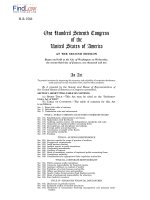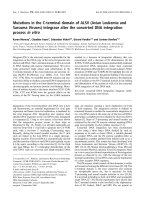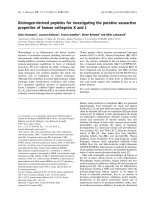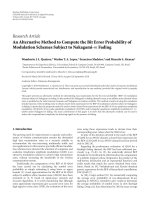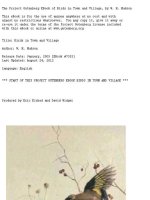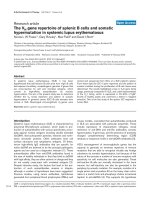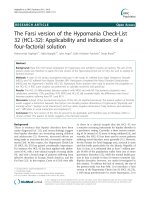ALTERNATIVE METHODS FOR STORING THE COLLECTION PRELIMINARY LIST OF OPTIONS - POINTS FOR AND AGAINST
Bạn đang xem bản rút gọn của tài liệu. Xem và tải ngay bản đầy đủ của tài liệu tại đây (123.54 KB, 24 trang )
APPENDIX 1
ALTERNATIVE METHODS FOR STORING THE COLLECTION
PRELIMINARY LIST OF OPTIONS - POINTS FOR AND AGAINST
A. Cryopreservation
Pro
Long term storage (Forsline, Towill et al. 1998)
Simple and space efficient(Forsline, Towill et
al. 1998)
Low maintenance requirements (Forsline,
Towill et al. 1998)
Desiccated dormant buds easily shipped
(Forsline, Towill et al. 1998)
Grafted trees can be forced into early
flowering (Forsline, Towill et al. 1998)
Con
Less suited for low cold hardy varieties
(Forsline, Towill et al. 1998)
US varieties more winter hardy (Forsline, Towill
et al. 1998)
Different desiccation, freezing and thawing
rates (cultivar specific) (Forsline, Towill et al.
1998)
Variable recovery rates (Forsline, Towill et
al. 1998)
May lose some accessions
Clonal integrity maintained (Forsline, Towill et
al. 1998)
Desiccation damage (Volk and Walters 2003a)
Material needs to be decontaminated (Volk and
Walters 2003a)
Some species need to go through tissueculture stage prior to cryopreservation
Precultural conditions of both vegetative parent
and explant material impact on success of
cryopreservation (Helliot and deBoucaud 1997;
Wu, Engelmann et al. 1999; Wu, Zhao et al.
2001; Volk and Walters 2003a)
Cryopreservation diffusion rates in larger
propagules may not be sufficient for survival
after cryopreservation (Volk and Walters
2003a)
Smaller explants susceptible to physical
damage of extraction and exposure to toxic
cryoprotectants (Volk and Walters 2003a)
Physiological condition important for health and
survival after cryopreservation (Wu,
Engelmann et al. 1999; Volk and Walters
2003a)
1
Mature specimens not available for
characterisation
Back up systems needed in case of
power/equipment failure
Meristem cryopreservation necessary for less
cold hardy species. e.g. Pyrus
Expensive development work(Volk and Walters
2003a)
Material not immediately available to growers
and other users
Long wait of years for production of flowers and
pollen for breeding purposes (especially for
Pyrus)
Genetic changes/damage possible
Not user friendly
Development work on content of collection not
possible
Loss of staff to maintain field collection results
in loss of technical backup and expert
knowledge
Cryopreservation of different types of material (Reed 2002)
Dormant buds
Readily available form field genebanks
In vitro shoot tips
Available at any time of the year
Easy to manipulate physically and
physiologically
Embryogenic cultures
Callus is generally easy to cryopreserve
Degree of cold hardiness varies with reason
and genotype
Buds only available for a few moths during the
winter
Requires more storage space than other
techniques
Requires grafting and budding expertise for
recovery
Techniques are not developed for all plants
Requires a laboratory and skilled workers
Not all plants produce somatic embryos
Genetic changes possible
2
Techniques are not broadly applicable across
species/accessions
Embryonic axes
Easy to remove and process
In vitro systems needed to recover whole
plants
Cryopreservation; Future studies (Volk and Walters 2003a)
•
•
•
•
Knowledge of biophysical properties of water within cells.
Physiological understanding of critical content for desiccation damage.
Hydraulic conductivity of water.
Thermal loads that effect cooling rates
To determine the effect of the physiology of starting material on the cryopreservation
of meristems
Development work needed for each species to find optimum conditions for
cryopreservation, thawing and recovery; (Slow freeze easier; large numbers can be
processed; conditions less critical; toxicity lower and success rate usually higher.
Vitrification marginally better if carried out experienced person.)
Understanding the stresses caused by drying, cooling, freezing and the effect of time
on these processes
A better understanding of the physiology and biochemistry of species to be
cryopreserved and of meristem biology
A better understanding of the effect of thawing on tissues
Examination of genetic erosion: what happens during cryo storage and what happens
during regeneration?
Work on the nature of toxicity of cryoprotectants
The investigation of beneficial elevated sugar levels in pre-culture
The examination of the reason for vine buds being ‘very leaky’. The effect of
electrolyte leakage on cryopreservability needs to be examined.
Evaluation of culture systems needed for recovery
Acclimation - Do cells of accessions which can be cryopreserved, produce their own
cryoprotectants?
Do species which can be cryopreserved have the ‘right’ genes or do susceptible
species fail to turn on their genes
Other questions: Ashworth, 1986 #74}
How do buds acclimate in the fall and increase in winter hardiness?
What factors limit the hardiness of buds?
What features distinguish a hardy from a non-hardy bud?
What factors and conditions are required to maintain maximum bud hardiness?
What controls the de-acclimation of flower buds and the progressive loss of cold
hardiness?
Notes
US varieties may be more tolerant of cryopreservation because of genetic make up
or exposure to harder winters producing hardening to a greater extent.
3
B. Tissue Culture
Pro
Con
Rapid multiplication possible if large numbers
required
Development work expensive and time
consuming(Volk and Walters 2003a)
No requirement for large land area
High maintenance costs
Not affected adverse weather
Labour intensive
Cultures easily transported
International transport possible
Accurate labelling at each subculture
necessary (real danger of errors due to
mislabelling)
Pest and disease-free stocks maintained
Propagation of recalcitrant species
Danger of microbial contamination (Volk and
Walters 2003b)
Ease of rooting (especially for woody
materials)
Promotes endophytic bacteria (Reed, Buckley
et al. 1995) (Reed, Mentzer et al. 1998)
Rapid regeneration documented for many of
NFC crops
Stresses of media additives to control
endophytic bacteria may decrease vigour and
survival of cultures. (Volk and Walters 2003a)
Ease of germplasm exchange and shipment
both within and between countries
Mite/thrip infection possible
Physiological changes with time/subcultures
Somaclonal variation(Swartz, Galletta et al.
1981)
Ploidy problems
Differences in growth and fruiting after
regeneration
Need light and temperature control
Need sterile working area
Delayed flowering
Mature specimens not available for
characterisation
Future studies in tissue culture:
Studies needed on the epigenetic effects (Phenotypic expression due to variation in
expression) and on plant and hormone physiology.
Assessment of hormonal and nutritional needs required in vitro.
Further studies in developmental biology to examine the induction of roots, multiple
shoots and flowers
4
The control of endophytic bacteria
The rejuvenation of woody species
Episotic growth (eg in vitro Oak cultures)
How to get recalcitrant species in culture
Factors responsible for cold sensitivity of grape in vitro
C. Low temperature tissue culture
Pro
As for tissue culture above
Maintenance and labour costs may be lower
than for standard tissue culture above
Less frequent subculture required
Con
As for tissue culture above,
although maintenance and labour costs may be
lower
Need to go through multiplication and rooting
media at 20oC (few months) before retuning to
cold.
Still labour intensive
Loss of some accessions
Needs system for producing vigorous shots
free of contaminants/endophytes prior to cold
storage
Development work:
At present, Ribes found to be too ‘dirty’ to be stored in cold storage tissue culture.
Need to develop method of removing surface contaminants and endophytes Pers.
Comm. Janine de Paz, (NCGR, Corvallis, Oregon, USA)
Factors effecting cold hardiness
Factors effecting bud break and survival at sub-optimum levels
The effect of reducing nutrient and sugar levels
D. DEFRA National Field Collection at Brogdale
Pro
Con
Morphological characteristics readily recorded
Labour intensive
Samples of propagating wood, leaves, fruit
and pollen available
High cost
Large acreage
Allows accessions to be characterised
Prone to attack from pathogens & pests
Allows users to select most appropriate
material
(Use of genetic markers/fingerprinting would
reduce time with parallel collections, i.e. would
reduce major cost)
Effected by extreme environmental conditions
Risk of vandalism
Climate changes may eventually effect fruiting
due to lack of winter chill for flower initiation
5
(User of material supplied responsible for
import permits and quarantines etc)
Position of accessions fixed in collection for
many years with site maps giving location
Need for re-propagation and parallel collections
M9 need stakes to support scions
Easier for public to see and appreciate
collection which may result in more monetary
support from foundations or the public-ie PR
exercise
Note:
At NCGR, accessions in pear collection cut back annually; either 25% off the top, or
left or right hand side of rows cut back with hedge trimmer on consecutive years to
reduce cost of maintaining trees at a manageable size, and keep trees rejuvenated.
Development work:
Need good genetic markers to identify accessions in field and those coming out of
cryopreservation. Research on genetic diversity can help define core collections for
field collections, so reducing collection size and costs. More reliable identification
(fingerprinting) of accessions which are relatively easy and cheap to run, are needed
Research is needed to develop health procedures during the collection and
introduction of new accessions into field gene-banks. Also faster and more efficient
ways of screening and disease indexing new accessions
Research is needed to improve management and maintenance of field collections
Development of low-input management strategies can help reduce costs of
maintaining field collections.
General procedures for field collections include propagation methods, selection of
planting sites, planting procedures, cultivation practices, disease and pest
management and harvest and storage of propagules. Monitoring the genetic stability
of the crop requires careful vigilance on the part of the curator and field staff, careful
roguing, labelling and protection of the plants from biotic and abiotic dangers are
important to the safety of the germplasm. (Reed et al, 2004)
6
E. Ultra Dwarfing Rootstock (e.g. M27 for apples)
Pro
Con
Less land required
Prone to pests and diseases
Material readily available
Prone to vandalism
Morphological characteristics readily recorded
Prone to climatic changes
Samples of propagating wood, leaves, fruit
and pollen available
May not show all characteristics of full-sized
plants
Allows accessions to be characterised
Fewer flowers (for breeders)
Allows users to select most appropriate
material
Less material available than standard trees
Position of accessions fixed in collection for
many years with site maps giving location
(Use of genetic markers/fingerprinting would
reduce time with parallel collections, i.e. would
reduce major cost)
(User of material supplied responsible for
import permits and quarantines etc)
May not produce enough fruit for crosses on
trees
Greater intensity of care necessary
Smaller root balls
M27 need wire frames to support scion
Shorter life
Doyenne du Comice interstock probably
needed for pears
More frequent re-propagation and parallel
collections
Effect of cherry and plum dwarfing rootstocks
(Gisela 5 and Pixy) on many scion cultivars not
known
Development work:
Need good genetic markers to identify accessions in field and those coming out of
cryopreservation
Importance of secondary structure of proteins for dried or frozen material
Effect of cherry and plum dwarfing rootstocks (Gisela 5 and Pixy) on many scion
cultivars is not known. Before using these very dwarfing rootstocks research will be
needed to look at the long term effects of growing a wide range of scions on such
rootstocks.
F. Cordons (for apples and pears)
7
Pro
Con
Less land required
Prone to pests and diseases
Material readily available
Prone to vandalism
Morphological characteristics readily recorded
Prone to climatic changes
Samples of propagating wood, leaves, fruit
and pollen available
More susceptible to Fire Blight
May not show all characteristics of full-sized
plants
Allows accessions to be characterised
Allows users to select most appropriate
material
Fewer flowers (for breeders)
Less material available than standard trees
Position of accessions fixed in collection for
many years with site maps giving location
(Use of genetic markers/fingerprinting would
reduce time with parallel collections, i.e. would
reduce major cost)
May not produce enough fruit for crosses on
trees (but could use pollen instead)
Greater intensity of care necessary
Posts and wires needed
(User of material supplied responsible for
import permits and quarantines etc)
Cherry and plums not well suited to cordon
cultivation
Development work:
Need good genetic markers to identify accessions in field and those coming out of
cryopreservation
G. Potted Plants
Pro
Con
Can be transported to new locations
Prone to drying out
Less land required
High regular commitment to watering
Morphological characteristics readily recorded
Large mature plants not possible
Samples of propagating wood, leaves, fruit
and pollen available
May not show all the characteristics of mature
plant
Allows accessions to be characterised
Periodic re-potting (Annual?)
Allows users to select most appropriate
material
Labour costs of re-potting etc
(Use of genetic markers/fingerprinting would
Loss of labels especially during re-potting
(mislabelling causes masses of work)
8
reduce time with parallel collections, i.e. would
reduce major cost)
(User of material supplied responsible for
import permits and quarantines etc)
Can be kept in a screen house to protect from
pests and extreme climatic conditions
Restricted access to public because of danger
of label theft
Shorter life (more frequent re-propagation)
Disease is more of a problem.
Effected by extreme environmental conditions
Risk of vandalism
Climate changes may eventually effect fruiting
due to lack of winter chill for flower initiation
Notes:
At NCGR, the problem of label loss is counteracted by pushing a second label,
upside-down, completely into the ground at the edge of the pot (so that it is not
obvious to the general public, and can also be retrieved if the visible label falls out by
accident).
Genetic fingerprinting of the whole collection would also help to overcome label loss.
Any doubts could be checked with the stored information.
9
H. Seed Storage
Pro
Con
Long term storage
May lose some accessions
Simple and space efficient
Mature specimens not available for
characterisation
Low maintenance requirements
Easy to use for appropriate seed types
(orthodox) i.e. small seeded desiccation
tolerant , cold tolerant, not clonally propagated
accessions (Reed 2002)
Not useful for large, cold sensitive or
desiccation intolerant seeds (recalcitrant) or
clonally propagated plants
(Reed 2002)
Back up systems needed in case of
power/equipment failure
Development work on content of collection not
possible
Loss of staff to maintain field collection results
in loss of technical backup and expert
knowledge
Seed increase process necessary when
number of seeds in accession falls below 100
or viability falls below acceptable level (eg tests
indicate that only probably 30 viable seeds
left)-Peters ,J., NCGR
Seed increase process time consuming –
Peters, J., NCGR
Note:
A seed collection would be complementary to, but not a replacement for a field
collection
Development work:
Developing a way of storing recalcitrant seeds
Importance of secondary structure of proteins for dried or frozen or frozen seeds
Effect of lipid composition of storage of seeds
How changes in volatiles can indicate deterioration of seeds
10
I. Pollen Storage
Pro
Con
Long term storage (Towill and Walters 2000)
May lose some accessions
Simple and space efficient (Towill and Walters
2000)
Mature specimens not available for
characterisation
Low maintenance requirements
Back up systems needed in case of
power/equipment failure
Desiccated dormant buds easily shipped
(Forsline, Towill et al. 1998)
Development work on content of collection not
possible
Easy for many plant genera (Reed 2002)
Loss of staff to maintain field collection results
in loss of technical backup and expert
knowledge
Useful for breeding (Reed 2002)
J. Leaf Storage
Pro
Long term storage
Con
Mature specimens not available for
characterisation
Simple and space efficient
Low maintenance requirements
Material readily available for DNA extraction
Back up systems needed in case of
power/equipment failure
Development work on content of collection not
possible
Loss of staff to maintain field collection results
in loss of technical backup and expert
knowledge
11
APPENDIX 2
Table A2.1 –
Number of Malus accessions cryopreserved at the USDAARS National Seed Storage Laboratory, Fort Collins, CO, showing acceptable
viability levels in recovery grafting at the Plant Genetic Resource Unit, Geneva,
NY.
Species
M. pumila
M. kansuensis
M. kirghisorum
M. x adstringens
M. x robusta
M. toringoides
M. sieboldii
M. asiatica
M. prunifolia
M. sargentii
M. x soulardii
M. hybrids (crabs)
M. ioensis
M. pumiia
M. sikkimensis
M. sylvestris
M. yunnanensis
M. sieversii
M. baccata
M. floribunda
M. hupehensis
M. spectabilis
M. coronaria
M. halliana
M. transitoria
M. micromalu
M. x magdeburgensis
M. fusca
M. angustifolia
M. honanensis
M. florentina
M. tschonoskii
M. trilobata
Total
Cryopreserved
487
2
1
1
5
2
3
1
5
4
2
42
10
1
4
2
5
2
5
1
2
1
20
2
1
3
1
13
3
3
5
2
1
642
Viability > 40%
452
2
1
1
5
2
3
1
5
4
2
40
8
1
4
2
4
2
5
1
2
1
15
1
1
2
0
5
1
1
1
0
0
575
From Forsline, P. L., J. R. McFerson, et al. (1999). Development of base and active
collections of Malus germplasm with cryopreserved dormant buds. Acta
Horticulturae; Proceedings of EUCARPIA Symposium on Fruit Breeding and
Genetics. K. R. Tobutt, Alston, F.H. Oxford, England. 484: 75-77.
12
Table A2.2 - Number of Malus accessions cryopreserved and recovered
by grafting in the active collection at the USDA-ARS Plant Genetics Resources
Unit, Geneva, NY.
Species
M. pumila
M. micromalus
M. hybrid
M. baccata
M. prunifolia
M. x magdeburgensis
M. spectabilis
M. honanensis
M. coronaria
M. x adstringens
M. florentina
Total
Cryopreserved
102
1
9
1
1
1
1
2
1
1
1
121
Viability > 40%
100
1
9
1
1
1
1
1
0
0
0
115
From Forsline, P. L., J. R. McFerson, et al. (1999). Development of base and active
collections of Malus germplasm with cryopreserved dormant buds. Acta
Horticulturae; Proceedings of EUCARPIA Symposium on Fruit Breeding and
Genetics. K. R. Tobutt, Alston, F.H. Oxford, England. 484: 75-77.
13
APPENDIX 3
DECISION FLOW CHART FOR CRYOPRESERVED
STORAGE OF CLONAL GERMPLASM
IDENTIFY
PRIORITY
GERMPLASM
DETERMINE
BEST
STORAGE FORM
PRIORITIZE
ACCESSIONS FOR
STORAGE
CHOOSE AN
APPROPRIATE
TECHNIQUE
SET UP DATABASE
OF NECESSARY
INFORMATION
SET UP TESTING
AND STORAGE
PROTOCOLS
LOCATE A SAFE
AND REMOTE
STORAGE SITE
PLAN
LONG-TERM
MONITORING
INITIATE
BASE
STORAGE
Fig. 1. Flow chart for cryopreserving clonal germplasm
From Reed, B. M. (2002). Implementing Cryopreservation for long-term germplasm
preservation in vegetatively propagated species. Cryopreservation of Plant
Germplasm II. L. E. Towill and Y. P. S. Bajaj. Berlin, Springer-Verlag. 50: 22-33.
14
Table A3.1. Storage forms for cryopreserved germplasm
Best Storage
Form
Plant groups
Advantages
Disadvantages
Seed
Small seeded,
desiccation tolerant,
cold tolerant, not
clonally propagated
Easy to use for
appropriate seed
types (orthodox)
Not useful for large, cold
sensitive or desiccation
intolerant seeds (recalcitrant)
or clonally propagated plants
Pollen
Many
Easy for many plant
genera, useful for
plant breeding
Preserves only half of the
genome
Dormant buds
Temperate woody
plants
Dormant buds are
readily available
from field
genebanks
Degree of cold hardiness
varies with season and
genotype, requires more
storage space than other
techniques, requires grafting
and budding expertise for
recovery
In vitro shoot
tips
Many
Available at any
time of year, easy to
manipulate
physically and
physiologically
Techniques are not developed
for all plants, requires a
laboratory and skilled workers
Embryogenic
cultures
Various plant groups
Callus is generally
easy to
cryopreserve
Not all plants produce somatic
embryos, techniques are not
broadly applicable across
species/accessions
Embryonic
axes
Some marginally
recalcitrant seed
types
Easy to remove and
process
In vitro systems are needed to
recover whole plants
Zygotic
embryos
Some marginally
recalcitrant seed
types
Removal of the
seed coat may
improve recovery
Time consuming and often
technically difficult
From
Reed, B. M. (2002). Implementing Cryopreservation for long-term germplasm
preservation in vegetatively propagated species. Cryopreservation of Plant
Germplasm II. L. E. Towill and Y. P. S. Bajaj. Berlin, Springer-Verlag. 50: 22-33.
15
APPENDIX 4
ALTERNATIVE METHODS FOR IDENTIFYING GENETIC RESOURCES
PRELIMINARY LIST OF OPTIONS - POINTS FOR AND AGAINST
A. RFLP techniques
(Restricted Fragment Length Polymorphism)
Pro
Con
Powerful for distinguishing apple accessions
(Weeden and Lamb 1985; Nybom 1990;
Mulcahy, Cresti et al. 1993)
Not easy (Korzun 2003)
(Use of genetic markers/fingerprinting would
reduce time with parallel collections, i.e. would
reduce major cost)
Not easy to automate(Korzun 2003)
Co-dominant: -i.e. contain twice as much
information, in a genetic cross, as dominant
markers (eg. RAPDs)
Large amount of DNA required(Korzun 2003)
Can use already-existing cDNA clones as
probes
Needs high level of skill
Need high DNA quality(Korzun 2003)
Time-consuming and expensive, compared to
other marker methods ; high cost per
analysis(Korzun 2003)
Requires many previously-cloned genes
Can re-probe Southern blots many times
Often only 1 polymorphism per probe
Highly-reproducible between labs (Korzun
2003)
Low development costs(Korzun 2003)
Probably the lowest success rate of any
method for detecting polymorphisms
Need to send probes between labs
Not really high resolution in terms of the
number of RFLPs per base pair
B. RAPD techniques
(Random Amplification of Polymorphic DNA)
Pro
Con
Successful discrimination of sports in
future (Pancaldi 1999)
Not very efficient in locating genetic differences
among mutants
Easy to use (Korzun 2003)
Failure to distinguish between sports and
original cultivar. (Harada , Matsukawa et al.
1993; Mulcahy, Cresti et al. 1993)
Do not need to clone anything to mark a
locus; primers applicable to any species
Low development cost(Korzun 2003)
Low cost per analysis(Korzun 2003)
Unreliable; differs from lab to lab and from
year to year. i.e. Useless (Ken Tobutt, pers
com.) Not reproducible
High quality DNA required
16
Probably cheapest and easiest method
for labs just beginning to use molecular
markers
RAPD bands can often be cloned and
sequenced to make SCAR (sequencecharacterized amplified region) markers
that are highly reproducible
Not easily reproducible between labs
Dominant: only half the genetic information as
co-dominant markers
Null alleles not directly detected
The lack of reproducibility of RAPDs can be
overcome by converting them to SCARS.
Often several polymorphisms (1.5 to 50)
per primer (Korzun 2003)
Only primer sequences are needed to
define a marker. Cloned probes are not
necessary.
Moderately amenable to automate
(Korzun 2003)
No previous knowledge of genome
required (Goulao, Cabrita et al. 2001).
Very small amount of DNA required per
analysis (Goulao, Cabrita et al. 2001)
C. Micro-satellites (SSR)
(Simple Sequence Repeat)
Pro
Con
Highly-reproducible between labs
Easy to use (Korzun 2003)
Large number of polymorphisms per primer
set
Often multiple alleles in a population, which
can be highly-informative
Co-dominant
Difficult to find good micro-satellite markers in
each species This problem being solved and
method becoming increasingly easy
High development costs
Moderate DNA quality required (Korzun 2003)
Fail to discriminate between sports and original
cultivar. (Gianfranceschi ,Seglias et al.1998;
Hokanson, Szewc-McFadden et al. 1998).
Cost effective deployment
Highly amenable to automation (Korzun 2003)
Highly reproducible (Korzun 2003)
Low cost per analysis (Korzun 2003)
Relatively simple
17
Most markers are monolucus and show
Mendelian inheritance
Highly informative
High number of public SSR primer pairs
available.
Amplifies specific marker. Linked to specific
allele
Suitable for diversity studies
EST (expressed Sequence Tag)
Facilitates development of micro-satellite markers (Varshney, Graner et al. 2005;
Varshney, Sigmund et al. 2005)
D. Incompatibility alleles
(S alleles)
Pro
Con
Easy to detect using PCR
May not be appropriate for Ribes
Allele specific primers available
In Pyrus, nomenclature confusing or
ambiguous. (ie multiple names for same
genotype)
Highly polymorphic
Easy to score and convert into genetic
interpretation
Relatively cheap (Similar to micro-satellite)
Rapidly progressing field
Suitable for diversity studies
Development work needed:
Need to establish uniform nomenclature for Pyrus,
18
E. Retro Transposan Tags
(RTT)
Pro
Con
Highly variable polymers
Development of appropriate primer sequences
Good for forensic studies
Need skill (for new taxa)
Has much of genome represented
High development costs
Can be linked to genes of interest
Not good for phylogenic/historical studies
Good for fine scale genetic structure
Useful for cultivar identification
The application of LTR Retrotransposons as molecular markers in described in detail
by Schulman, Flavell et al. (2003).
F. SNP
(Single Nucleotide Polymorphism)
Pro
Con
Easy to use (Korzun 2003)
Inappropriate for detecting duplicates
Highly amenable to automation(Korzun 2003)
Highly reproducible(Korzun 2003)
Low cost per analysis(Korzun 2003) ; similar
to SSR system- getting cheaper
High development costs (eg $40,000 to
develop system for11 sequences for grapes)
Only one polymorph per probe
Can be used to detect alleles if linked to
specific genotype
Can be used for haploid type analysis
Sequence information available for grapes
and apple
PGRU is the only place in US where
sequence based resolution has been worked
out (May 2005)
Suitable for diversity studies
19
G. AFLP techniques (Amplified Fragment Length Polymorphism)
Pro
Con
No sequence information required
Very large number of polymorphisms per
reaction (20-100)
Probably the most polymorphisms for the cost
Straightforward and reliable
Easy to use
Moderately amenable to automation(Korzun
2003)
High reproducibility (Korzun 2003)
Moderate development costs
Moderate cost per analysis
Not-reliable to convert AFLPs into SCARs
Proprietary technology
Null allele not detected
Moderate DNA quality required(Korzun 2003)
Technically rather difficult
May need radioactivity or silver staining
(environmentally suspect) for running gels on
plates but not if capillary separation used
Difficult to interpret
Difficult to convert to simple genetic/arithmetic
information
Data may need to be stored as images
Difficult to reproduce with 100% reliability
Could be useful for confirmation
Difficult to compare patterns
May be useful for disciminating clones
20
APPENDIX 5
DNA marker information (supplied by Dr.Cameron Peace)
Rosaceae is also considered the model family (and Prunus the model genus) for
fruit/nut trees,
To DNA fingerprint the entire collection, DNA extraction needs to be done first. This is
a relatively large initial cost.
(If the cherries at least were previously fingerprinted, then perhaps DNA samples can
be obtained from East Malling Research.)
Each accession should have its DNA extracted in duplicate, then after a few initial
DNA tests, any blanks re-extracted, until two replicate samples are available for each
accession. Replicating (and running each side-by-side in the DNA tests to allow easy
scoring) is important for a long-term collection such as the NFC, where users will
want to test over and over again for many things
The next concern is the type of extraction method to use. There are long extraction
methods, which result in very good quality DNA samples but typically less than ten
can be performed by a single person per day, and there are quick methods, which
result in lower quality DNA that is fine for most PCR tests (but not so good where
restriction is required like in RFLP or AFLP) and 50
or more samples could be extracted per person per day (even a hundred or more, if
leaf material has been previously prepared - freeze-dried then ground to a fine
powder in a ball mill or some such). Given such a massive collection, a quick method
is recommended as long as equipment exists to easily powder the leaves.
The marker systems to be used for DNA fingerprinting the collection depend on the
desired outcome. First there is just general identity and genetic diversity analysis where identity analysis would identify duplicate accessions, and then when profiles
are compared across all typed individuals, a picture of genetic relationships/diversity
emerges. This could use multiplex dominant marker systems such as RAF or AFLP,
or single-locus marker systems such as microsatellites.
Microsatellites are hyper-variable and have already been developed for most of these
species, and in most cases, work has been done to combine these so that several
can be run at once. For these reasons, I strongly recommend this marker system for
identity and diversity analysis of the collection.
The second desired outcome for screening the collection is to identify diversity in
specific useful genes. This requires that useful genes and their specific sequences
are already known. Good examples are the S-allele test for cherries (and other selfincompatible Prunus) and, endoPG for Prunus fruit softening. There are several
interesting genes already known for apple (esp. for disease resistance), several for
Prunus, and probably Vitis too. Many of these gene tests are probably transferable,
so some testing could still be done in those cases. Then in the future as researchers
in each of these crops identify new useful genes and develop tests for them, the
collection can be screened using the DNA library.
Costs
DNA extraction costs are mostly labour,
21
The number of accessions divided by the number of samples that can be extracted
per day, multiplied by 150%,
equals the number of man-days required. This can be done by a technician-level
scientist.
Running the DNA tests depends on the technology available. An automated system
that can run many hundreds of
samples per day given the size of the collection, is recommended.
More automated marker systems.
Capital costs (1$=£0.55 June, 2005)
These costs are approximate and for the US, The automated systems compared
here are an ABI3100 and LiCor, perhaps the two most commonly used
brands/machines. The ABI is more efficient and more accurate, and considered the
best on the market. The ABI can be set up as a 16 (better for a smaller lab) or 96
(more expensive, better if there are many many samples) capillary system.
Cost to buy: $130,000 (LiCor or ABI with 16 capillary system), $500,000 (ABI with 96
capillary system)
Maintenance costs: $10,000 pa (LiCor or ABI/16, probably proportionally more for the
ABI/96) - this is basically an ongoing warranty but considered to be worth it.
Running costs:
LiCor (cheaper, as most can be prepared in the lab): approx. $0.50 per
sample.
ABI/16 (must buy gel and other necessities from the ABI company): approx.
$1.25 per sample. Plus $1000 per "array", where one array will last for 400-500 runs
(so I calculate from this that with about 570 samples per day [= per run], you'd need a
new array every 250,000 samples, which is less than a cent a sample. Basically
negligible. One array would last for something like 50 to 70 separate DNA tests per
sample, i.e. 25 to 35 DNA tests per accession when everything is done in duplicate).
ABI/96: $1.25 per sample, $4000 per array
Samples per day (with one trained technician):
LiCor: 95 samples, or can multiplex 2 tests at a time (i.e. 190 samples per
day)
ABI (16 capillary): 190 samples, or can multiplex up to 4 tests at a time (i.e.
760 samples per day for x4 multiplex)
ABI (96 capillary): 96 samples with 30-36 multiplexing (i.e. 3000-3600
samples per day)
IF there were 30 DNA tests (perhaps 20 SSRs and 10 candidate genes) that were
desired to be run across all ~4000 accessions of the collection. Assuming the
machines were already available/bought, and the DNA already extracted in duplicate
per accession, then the costs for running the 16 capillary ABI would be:
* No. samples = 8000 DNA extracts x 30 DNA tests = 240,000
* No. samples per day = 500 (with multiplexing, and allowing for reruns where
necessary)
* No. 1-person days required = 240,000 / 500 = 480
* Labour costs = 480 days x $100-$150 per day (£50-70.) = $48,000 to
$72,000.
22
* Running costs = 240,000 x $1.25 = $320,000
* Total cost = $368,000 to $392,000 plus the yearly maintenance cost.
480 days of continuously running the ABI probably difficult especially if more than 30
DNA tests are desired, so the 96 capillary system would probably be the best way to
handle so many samples.
Same calculations for the LiCor:
* No. samples = 240,000
* No. samples per day = 150 (with multiplexing, and allowing for reruns where
necessary)
* No. 1-person days required = 240,000 / 150 = 1600
* Labour costs = 1600 days x $100-$150 per day = $160,000 to $240,000.
* Running costs = 240,000 x $0.50 = $120,000
* Total cost = $280,000 to $360,000 plus the yearly maintenance cost. A little
cheaper, but takes a lot longer.
Same calculations for ABI/96:
* No. samples = 240,000
* No. samples per day = 2500 (with multiplexing, and allowing for reruns
where necessary)
* No. 1-person days required = 240,000 / 2500 = 96
* Labour costs = 96 days x $100-$150 per day = $10,000 to $15,000.
* Running costs = 240,000 x $1.25 = $320,000
* Total cost = $330,000 to $335,000 plus the yearly maintenance cost. Similar
price but so much quicker, and most desirable when many different DNA
tests are to be conducted over the years.
Same calculations for simple polyacrylamide gels (for simplicity assuming silver
staining rather than radioactivity):
* No. samples = 240,000
* No. samples per day = 75 (with multiplexing, and allowing for reruns where
necessary)
* No. 1-person days required = 240,000 / 75 = 3200
* Labour costs = 3200 days x $100-$150 per day = $320,000 to $480,000.
* Running costs = 240,000 x $0.75 = $160,000
* Total cost = $480,000 to $640,000
It is possible with the LiCor and polyacrylamide to multi-load each gel, allowing 4x as
many samples to be run in a day. This would reduce the number of days for the LiCor
to 400 and the polyacrylamide to 800, and so the total costs for Licor would be
$200,000-$220,000, and $240,000-$280,000 for polyacrylamide. For all of the above, labour needs
probably aren't quite realistic, because to prepare more than 100 samples a day, you'd need more
people on the job. Maybe 500 samples could be prepared per day per person, assuming a couple of
PCR machines (~$5000 each to purchase) are available per person. So for
240,000 samples, it would take perhaps 480 person-days, costing $48,000-$72,000,
just to prepare the samples for the machines.
23
APPENDIX 6
The following have expressed a wish to be involved in any future work which may
arise as a result of recommendations made in this report on ‘Safeguarding the
national fruit collection’.
Dr. Nahla V. Bassil, NCGR, 33447 Peorria Road,Corvallis, Oregon 97331, ASA
Dr. Angela Baldo, PGRU, Cornell University, Geneva, NY 14456, USA
Professor Phil Forsline, PGRU, Cornell University, Geneva, NY 14456, USA
Dr. Ken Tobutt, , East Malling Research, Maidstone, Kent
Radovan Boskovic, East Malling Research, Maidstone, Kent
Dr. David Smith, Curator of Genetic Resources Collection, CABI Bioscience,
Bakeham Lane, Egham, Surrey, TW20 9TY
Dr. Nigel Maxted, School of Biosciences, University of Birmingham, Birmingham B15
2TT
Cameron Peace, Kearney agricultural Center, 9240 S. Riverbend Av., Parlier, CA
93648, USA
Professor David C.Lynch, Professor of Plant Biotechnology,
Biological Sciences, School of Education, Health and Science, University of Derby,
Kedleston Road, Derby, DE22 1GB
Dr. Keith Harding,
Conservation & Environmental Chemistry Centre, School of Contemporary Sciences,
Kydd Building, University of Abertay, Dundee, Bell Street, Dundee, Scotland,DD1
1HG,
Dr Rex M. Brennan, Fruit breeding Group, Genome Dynamic Programme, Scottish
Crop Research Institute, Inergowie, Dundee Scotland DD1 5DD
24
